Management Accounting: Cost Analysis, Budgetary Control Methods
VerifiedAdded on 2023/06/18
|14
|3784
|59
Report
AI Summary
This report provides a comprehensive overview of management accounting, focusing on its definition, requirements, and differences from financial accounting. It explores various management accounting systems like cost accounting, job costing, inventory management, and price optimization. The report also analyzes methods for management accounting reporting, including budget reports, accounts receivable aging, inventory reports, job cost reports, operating budget reports, profit and loss statements, and performance reports. Furthermore, it calculates costs using marginal and absorption costing techniques to prepare income statements. The advantages and disadvantages of planning tools for budgetary control, such as activity-based budgeting, are discussed. Finally, it examines how organizations use management accounting systems to address financial challenges. Desklib is a platform where students can find similar solved assignments and study tools.
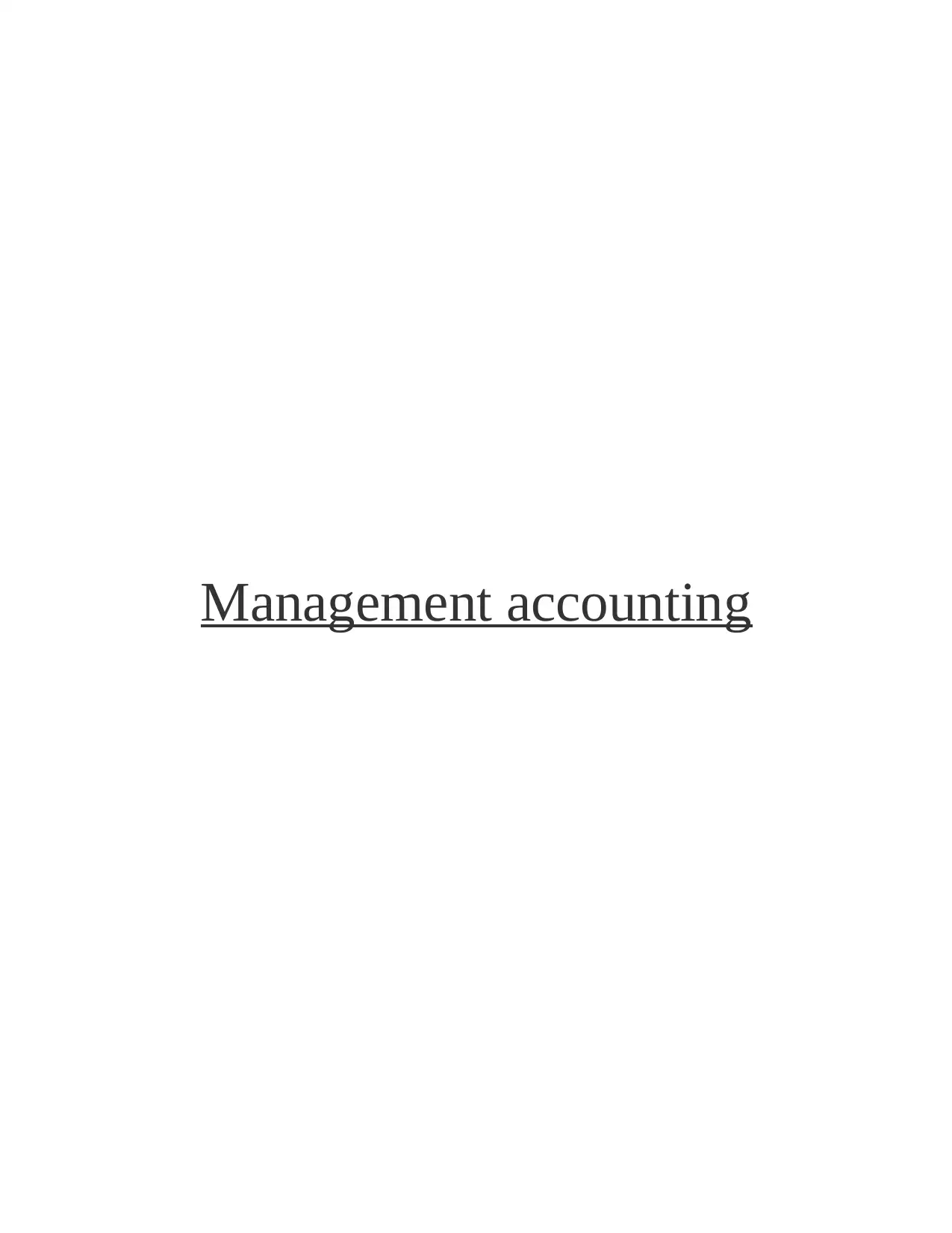
Management accounting
Paraphrase This Document
Need a fresh take? Get an instant paraphrase of this document with our AI Paraphraser
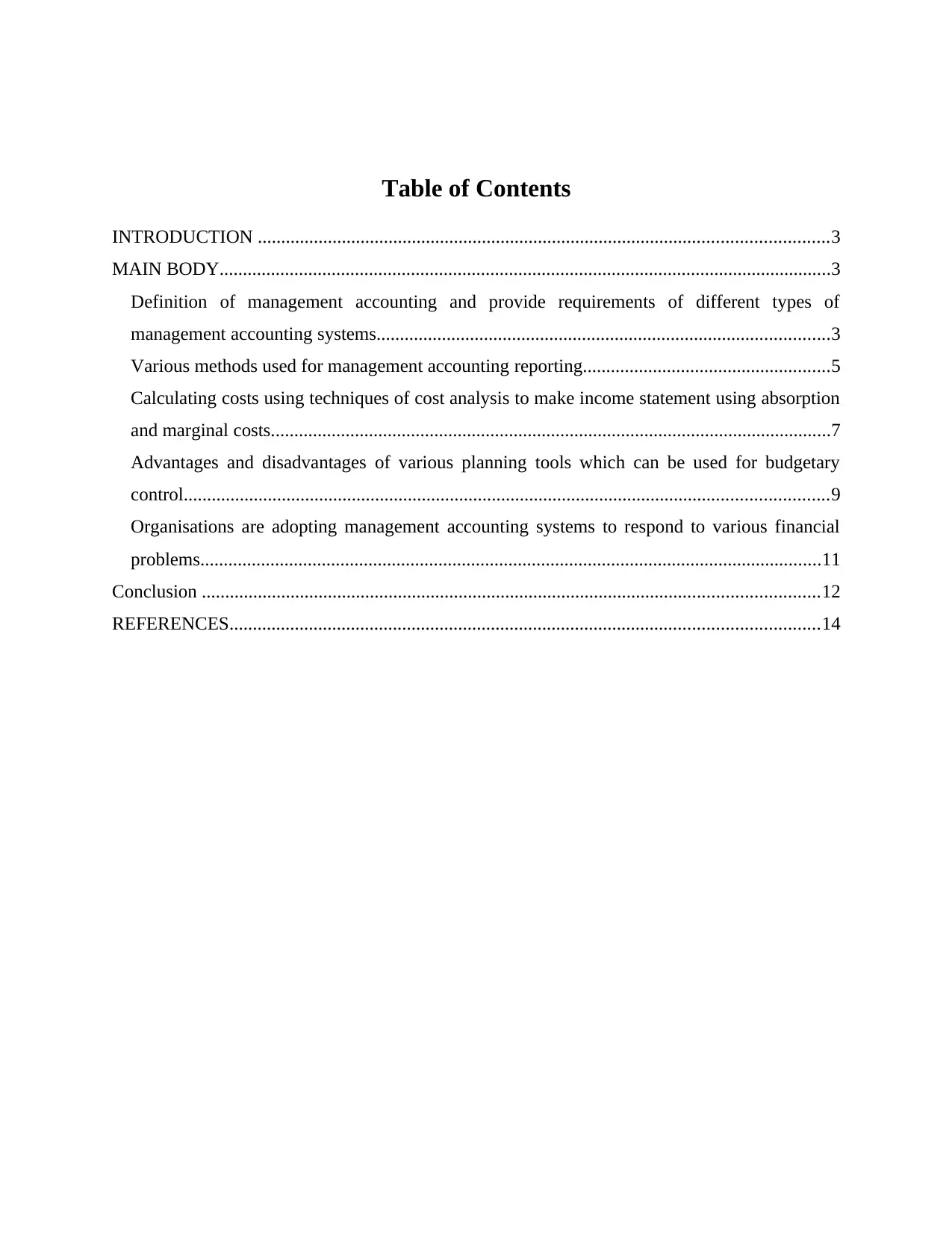
Table of Contents
INTRODUCTION ..........................................................................................................................3
MAIN BODY...................................................................................................................................3
Definition of management accounting and provide requirements of different types of
management accounting systems.................................................................................................3
Various methods used for management accounting reporting.....................................................5
Calculating costs using techniques of cost analysis to make income statement using absorption
and marginal costs........................................................................................................................7
Advantages and disadvantages of various planning tools which can be used for budgetary
control..........................................................................................................................................9
Organisations are adopting management accounting systems to respond to various financial
problems.....................................................................................................................................11
Conclusion ....................................................................................................................................12
REFERENCES..............................................................................................................................14
INTRODUCTION ..........................................................................................................................3
MAIN BODY...................................................................................................................................3
Definition of management accounting and provide requirements of different types of
management accounting systems.................................................................................................3
Various methods used for management accounting reporting.....................................................5
Calculating costs using techniques of cost analysis to make income statement using absorption
and marginal costs........................................................................................................................7
Advantages and disadvantages of various planning tools which can be used for budgetary
control..........................................................................................................................................9
Organisations are adopting management accounting systems to respond to various financial
problems.....................................................................................................................................11
Conclusion ....................................................................................................................................12
REFERENCES..............................................................................................................................14
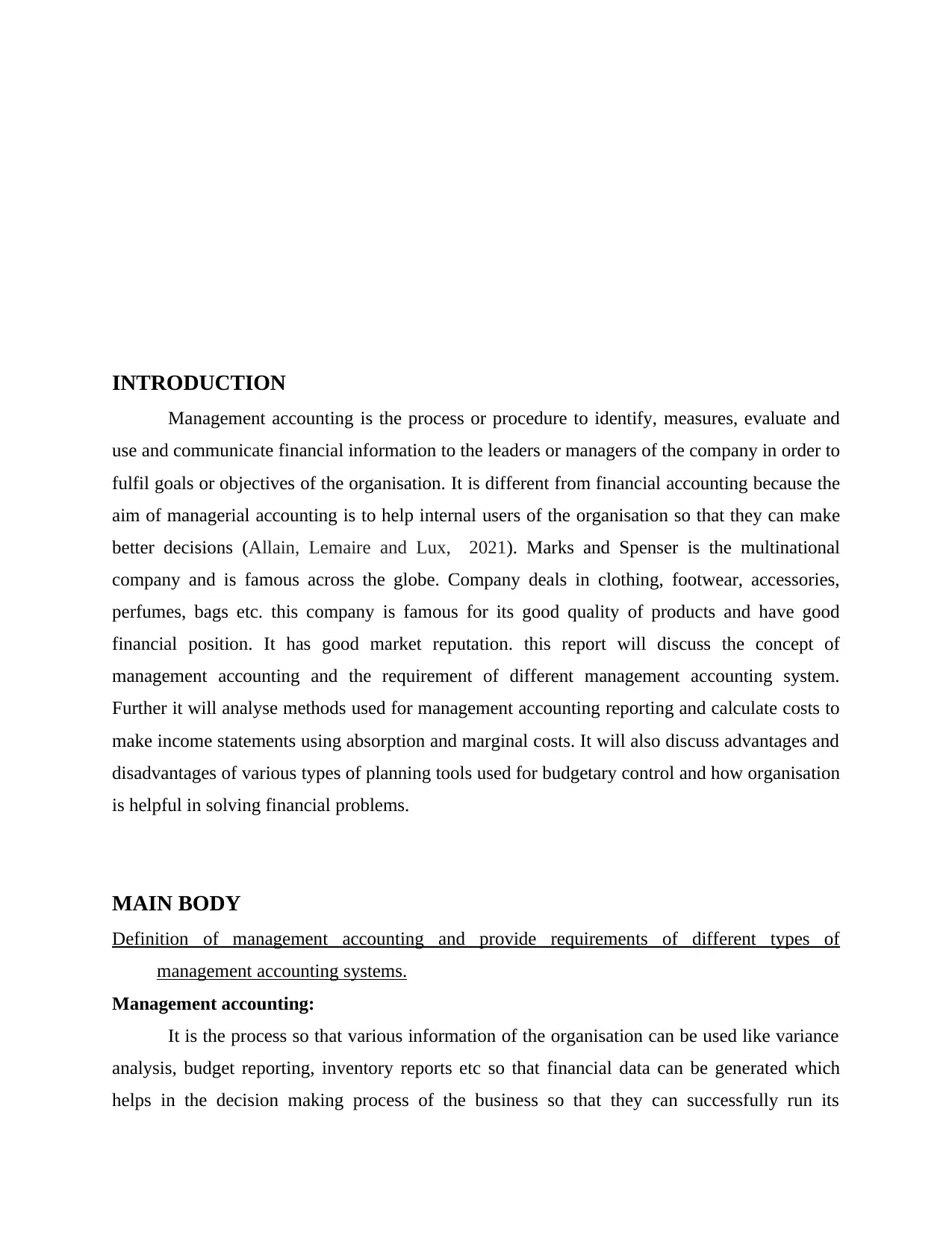
INTRODUCTION
Management accounting is the process or procedure to identify, measures, evaluate and
use and communicate financial information to the leaders or managers of the company in order to
fulfil goals or objectives of the organisation. It is different from financial accounting because the
aim of managerial accounting is to help internal users of the organisation so that they can make
better decisions (Allain, Lemaire and Lux, 2021). Marks and Spenser is the multinational
company and is famous across the globe. Company deals in clothing, footwear, accessories,
perfumes, bags etc. this company is famous for its good quality of products and have good
financial position. It has good market reputation. this report will discuss the concept of
management accounting and the requirement of different management accounting system.
Further it will analyse methods used for management accounting reporting and calculate costs to
make income statements using absorption and marginal costs. It will also discuss advantages and
disadvantages of various types of planning tools used for budgetary control and how organisation
is helpful in solving financial problems.
MAIN BODY
Definition of management accounting and provide requirements of different types of
management accounting systems.
Management accounting:
It is the process so that various information of the organisation can be used like variance
analysis, budget reporting, inventory reports etc so that financial data can be generated which
helps in the decision making process of the business so that they can successfully run its
Management accounting is the process or procedure to identify, measures, evaluate and
use and communicate financial information to the leaders or managers of the company in order to
fulfil goals or objectives of the organisation. It is different from financial accounting because the
aim of managerial accounting is to help internal users of the organisation so that they can make
better decisions (Allain, Lemaire and Lux, 2021). Marks and Spenser is the multinational
company and is famous across the globe. Company deals in clothing, footwear, accessories,
perfumes, bags etc. this company is famous for its good quality of products and have good
financial position. It has good market reputation. this report will discuss the concept of
management accounting and the requirement of different management accounting system.
Further it will analyse methods used for management accounting reporting and calculate costs to
make income statements using absorption and marginal costs. It will also discuss advantages and
disadvantages of various types of planning tools used for budgetary control and how organisation
is helpful in solving financial problems.
MAIN BODY
Definition of management accounting and provide requirements of different types of
management accounting systems.
Management accounting:
It is the process so that various information of the organisation can be used like variance
analysis, budget reporting, inventory reports etc so that financial data can be generated which
helps in the decision making process of the business so that they can successfully run its
⊘ This is a preview!⊘
Do you want full access?
Subscribe today to unlock all pages.

Trusted by 1+ million students worldwide
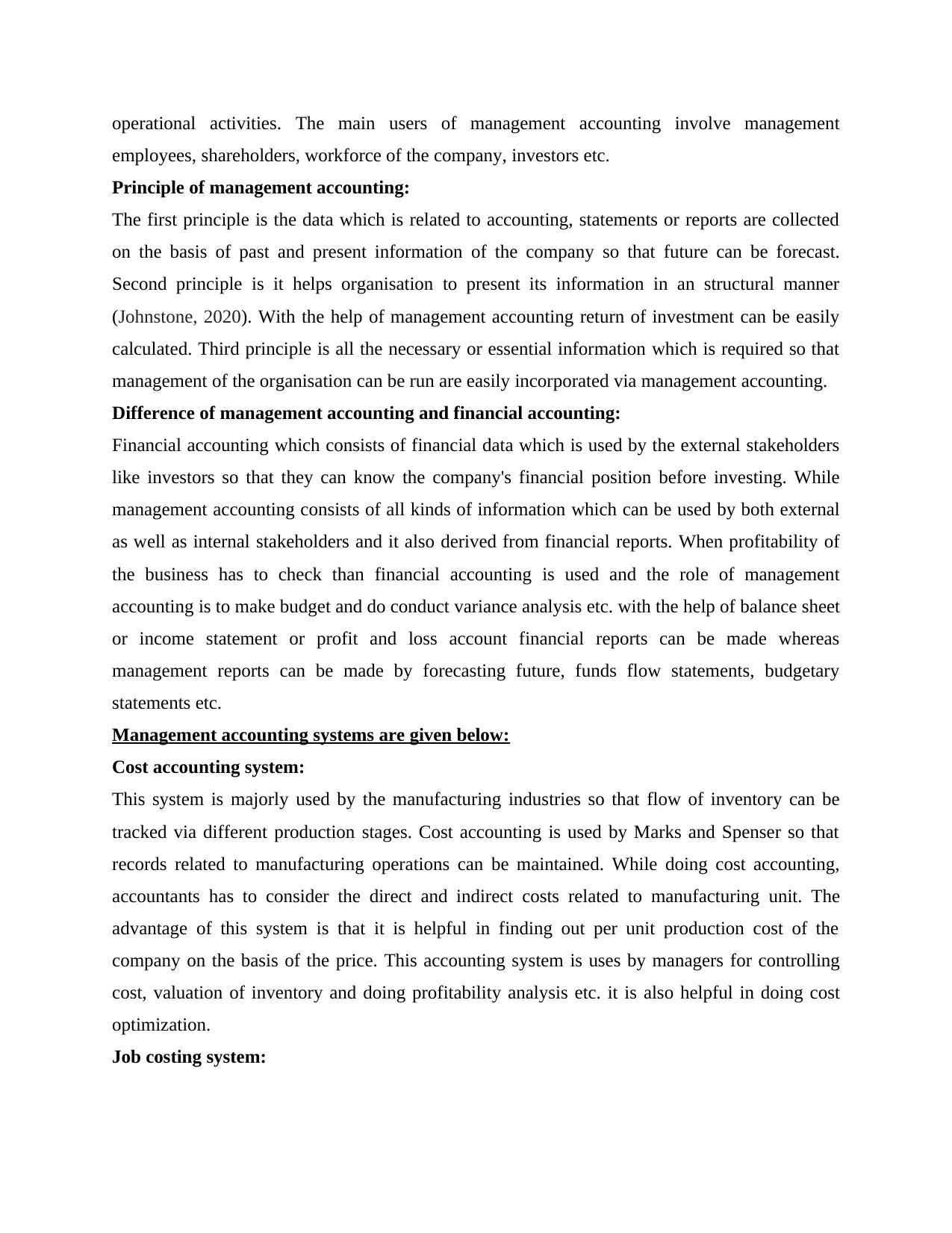
operational activities. The main users of management accounting involve management
employees, shareholders, workforce of the company, investors etc.
Principle of management accounting:
The first principle is the data which is related to accounting, statements or reports are collected
on the basis of past and present information of the company so that future can be forecast.
Second principle is it helps organisation to present its information in an structural manner
(Johnstone, 2020). With the help of management accounting return of investment can be easily
calculated. Third principle is all the necessary or essential information which is required so that
management of the organisation can be run are easily incorporated via management accounting.
Difference of management accounting and financial accounting:
Financial accounting which consists of financial data which is used by the external stakeholders
like investors so that they can know the company's financial position before investing. While
management accounting consists of all kinds of information which can be used by both external
as well as internal stakeholders and it also derived from financial reports. When profitability of
the business has to check than financial accounting is used and the role of management
accounting is to make budget and do conduct variance analysis etc. with the help of balance sheet
or income statement or profit and loss account financial reports can be made whereas
management reports can be made by forecasting future, funds flow statements, budgetary
statements etc.
Management accounting systems are given below:
Cost accounting system:
This system is majorly used by the manufacturing industries so that flow of inventory can be
tracked via different production stages. Cost accounting is used by Marks and Spenser so that
records related to manufacturing operations can be maintained. While doing cost accounting,
accountants has to consider the direct and indirect costs related to manufacturing unit. The
advantage of this system is that it is helpful in finding out per unit production cost of the
company on the basis of the price. This accounting system is uses by managers for controlling
cost, valuation of inventory and doing profitability analysis etc. it is also helpful in doing cost
optimization.
Job costing system:
employees, shareholders, workforce of the company, investors etc.
Principle of management accounting:
The first principle is the data which is related to accounting, statements or reports are collected
on the basis of past and present information of the company so that future can be forecast.
Second principle is it helps organisation to present its information in an structural manner
(Johnstone, 2020). With the help of management accounting return of investment can be easily
calculated. Third principle is all the necessary or essential information which is required so that
management of the organisation can be run are easily incorporated via management accounting.
Difference of management accounting and financial accounting:
Financial accounting which consists of financial data which is used by the external stakeholders
like investors so that they can know the company's financial position before investing. While
management accounting consists of all kinds of information which can be used by both external
as well as internal stakeholders and it also derived from financial reports. When profitability of
the business has to check than financial accounting is used and the role of management
accounting is to make budget and do conduct variance analysis etc. with the help of balance sheet
or income statement or profit and loss account financial reports can be made whereas
management reports can be made by forecasting future, funds flow statements, budgetary
statements etc.
Management accounting systems are given below:
Cost accounting system:
This system is majorly used by the manufacturing industries so that flow of inventory can be
tracked via different production stages. Cost accounting is used by Marks and Spenser so that
records related to manufacturing operations can be maintained. While doing cost accounting,
accountants has to consider the direct and indirect costs related to manufacturing unit. The
advantage of this system is that it is helpful in finding out per unit production cost of the
company on the basis of the price. This accounting system is uses by managers for controlling
cost, valuation of inventory and doing profitability analysis etc. it is also helpful in doing cost
optimization.
Job costing system:
Paraphrase This Document
Need a fresh take? Get an instant paraphrase of this document with our AI Paraphraser
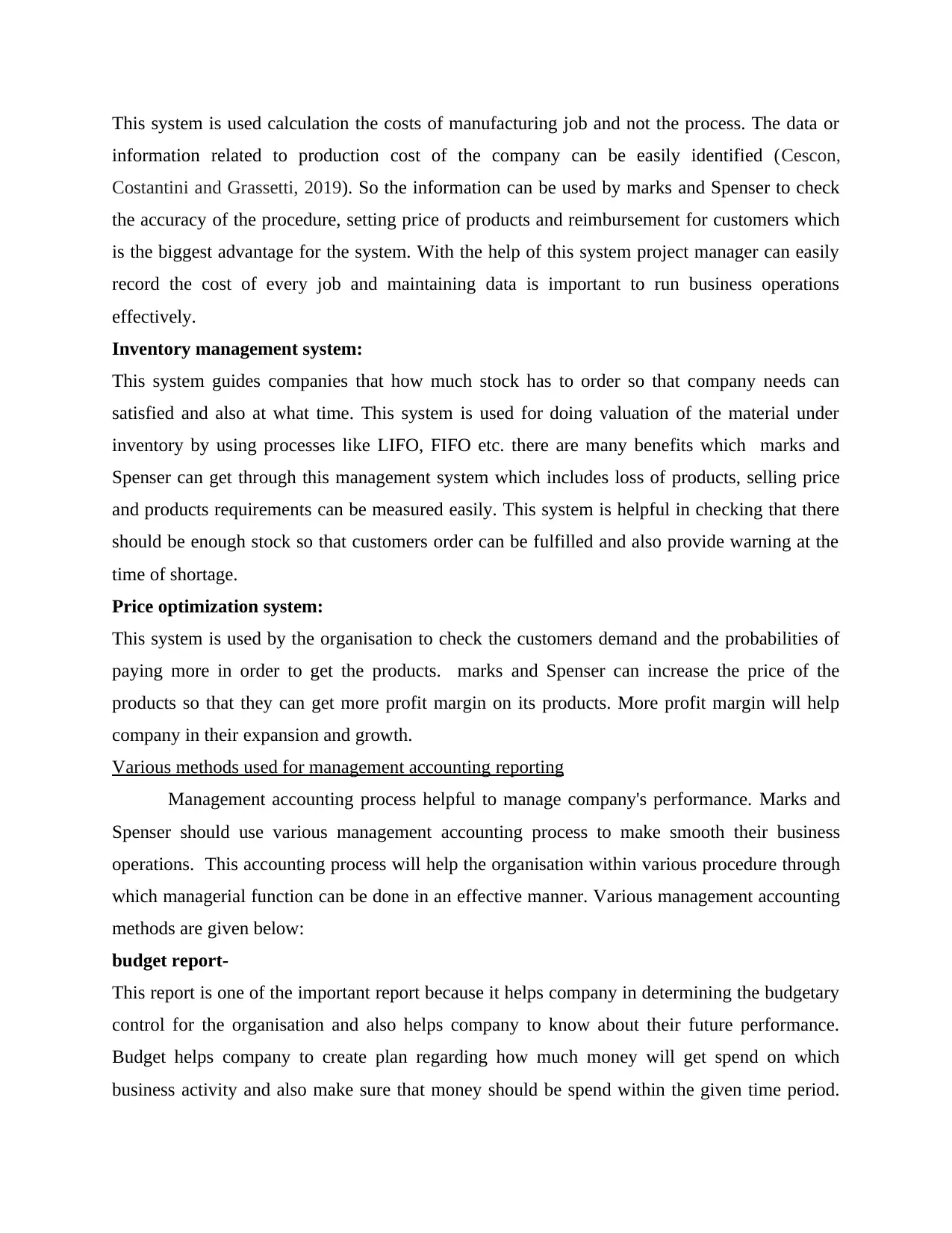
This system is used calculation the costs of manufacturing job and not the process. The data or
information related to production cost of the company can be easily identified (Cescon,
Costantini and Grassetti, 2019). So the information can be used by marks and Spenser to check
the accuracy of the procedure, setting price of products and reimbursement for customers which
is the biggest advantage for the system. With the help of this system project manager can easily
record the cost of every job and maintaining data is important to run business operations
effectively.
Inventory management system:
This system guides companies that how much stock has to order so that company needs can
satisfied and also at what time. This system is used for doing valuation of the material under
inventory by using processes like LIFO, FIFO etc. there are many benefits which marks and
Spenser can get through this management system which includes loss of products, selling price
and products requirements can be measured easily. This system is helpful in checking that there
should be enough stock so that customers order can be fulfilled and also provide warning at the
time of shortage.
Price optimization system:
This system is used by the organisation to check the customers demand and the probabilities of
paying more in order to get the products. marks and Spenser can increase the price of the
products so that they can get more profit margin on its products. More profit margin will help
company in their expansion and growth.
Various methods used for management accounting reporting
Management accounting process helpful to manage company's performance. Marks and
Spenser should use various management accounting process to make smooth their business
operations. This accounting process will help the organisation within various procedure through
which managerial function can be done in an effective manner. Various management accounting
methods are given below:
budget report-
This report is one of the important report because it helps company in determining the budgetary
control for the organisation and also helps company to know about their future performance.
Budget helps company to create plan regarding how much money will get spend on which
business activity and also make sure that money should be spend within the given time period.
information related to production cost of the company can be easily identified (Cescon,
Costantini and Grassetti, 2019). So the information can be used by marks and Spenser to check
the accuracy of the procedure, setting price of products and reimbursement for customers which
is the biggest advantage for the system. With the help of this system project manager can easily
record the cost of every job and maintaining data is important to run business operations
effectively.
Inventory management system:
This system guides companies that how much stock has to order so that company needs can
satisfied and also at what time. This system is used for doing valuation of the material under
inventory by using processes like LIFO, FIFO etc. there are many benefits which marks and
Spenser can get through this management system which includes loss of products, selling price
and products requirements can be measured easily. This system is helpful in checking that there
should be enough stock so that customers order can be fulfilled and also provide warning at the
time of shortage.
Price optimization system:
This system is used by the organisation to check the customers demand and the probabilities of
paying more in order to get the products. marks and Spenser can increase the price of the
products so that they can get more profit margin on its products. More profit margin will help
company in their expansion and growth.
Various methods used for management accounting reporting
Management accounting process helpful to manage company's performance. Marks and
Spenser should use various management accounting process to make smooth their business
operations. This accounting process will help the organisation within various procedure through
which managerial function can be done in an effective manner. Various management accounting
methods are given below:
budget report-
This report is one of the important report because it helps company in determining the budgetary
control for the organisation and also helps company to know about their future performance.
Budget helps company to create plan regarding how much money will get spend on which
business activity and also make sure that money should be spend within the given time period.
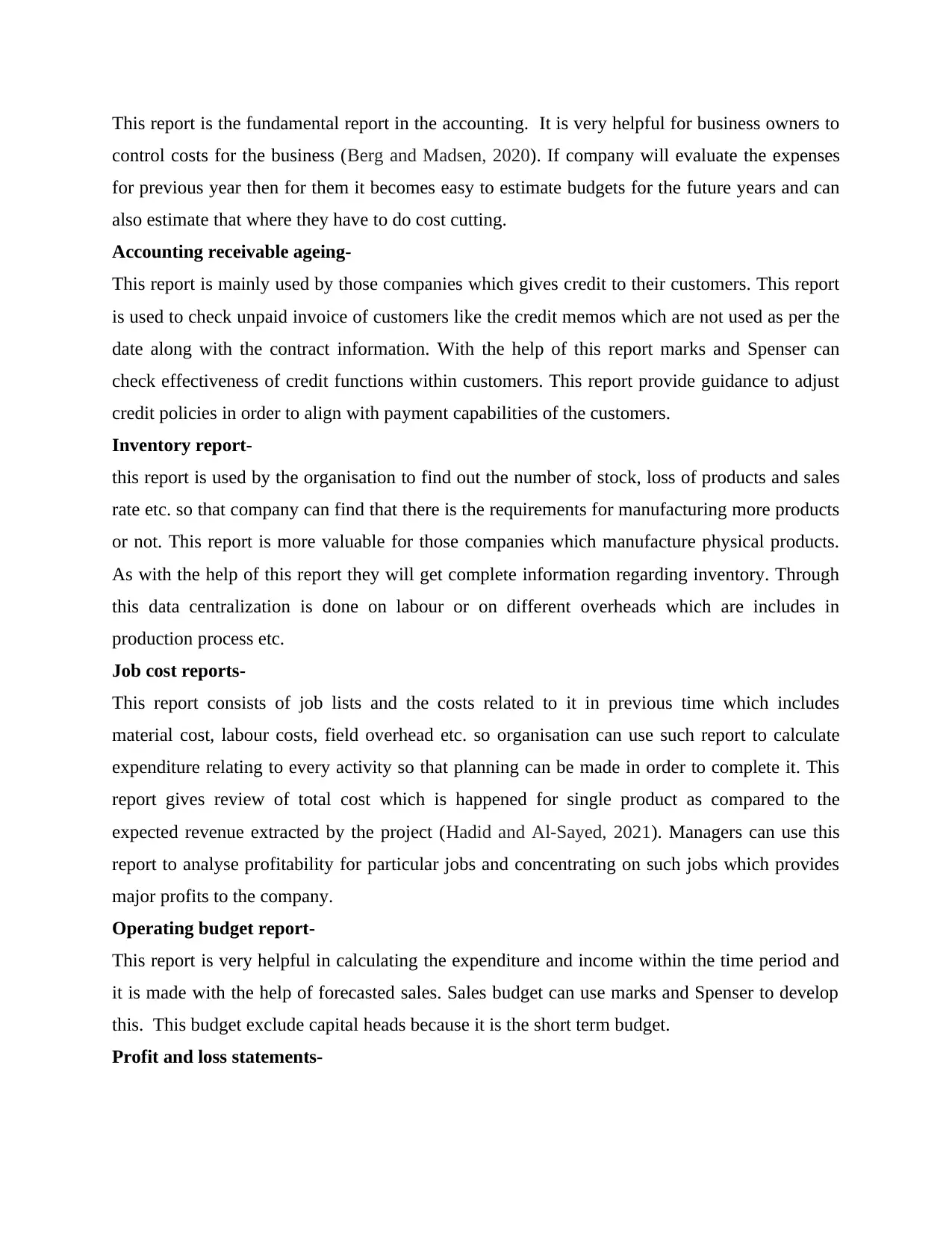
This report is the fundamental report in the accounting. It is very helpful for business owners to
control costs for the business (Berg and Madsen, 2020). If company will evaluate the expenses
for previous year then for them it becomes easy to estimate budgets for the future years and can
also estimate that where they have to do cost cutting.
Accounting receivable ageing-
This report is mainly used by those companies which gives credit to their customers. This report
is used to check unpaid invoice of customers like the credit memos which are not used as per the
date along with the contract information. With the help of this report marks and Spenser can
check effectiveness of credit functions within customers. This report provide guidance to adjust
credit policies in order to align with payment capabilities of the customers.
Inventory report-
this report is used by the organisation to find out the number of stock, loss of products and sales
rate etc. so that company can find that there is the requirements for manufacturing more products
or not. This report is more valuable for those companies which manufacture physical products.
As with the help of this report they will get complete information regarding inventory. Through
this data centralization is done on labour or on different overheads which are includes in
production process etc.
Job cost reports-
This report consists of job lists and the costs related to it in previous time which includes
material cost, labour costs, field overhead etc. so organisation can use such report to calculate
expenditure relating to every activity so that planning can be made in order to complete it. This
report gives review of total cost which is happened for single product as compared to the
expected revenue extracted by the project (Hadid and Al-Sayed, 2021). Managers can use this
report to analyse profitability for particular jobs and concentrating on such jobs which provides
major profits to the company.
Operating budget report-
This report is very helpful in calculating the expenditure and income within the time period and
it is made with the help of forecasted sales. Sales budget can use marks and Spenser to develop
this. This budget exclude capital heads because it is the short term budget.
Profit and loss statements-
control costs for the business (Berg and Madsen, 2020). If company will evaluate the expenses
for previous year then for them it becomes easy to estimate budgets for the future years and can
also estimate that where they have to do cost cutting.
Accounting receivable ageing-
This report is mainly used by those companies which gives credit to their customers. This report
is used to check unpaid invoice of customers like the credit memos which are not used as per the
date along with the contract information. With the help of this report marks and Spenser can
check effectiveness of credit functions within customers. This report provide guidance to adjust
credit policies in order to align with payment capabilities of the customers.
Inventory report-
this report is used by the organisation to find out the number of stock, loss of products and sales
rate etc. so that company can find that there is the requirements for manufacturing more products
or not. This report is more valuable for those companies which manufacture physical products.
As with the help of this report they will get complete information regarding inventory. Through
this data centralization is done on labour or on different overheads which are includes in
production process etc.
Job cost reports-
This report consists of job lists and the costs related to it in previous time which includes
material cost, labour costs, field overhead etc. so organisation can use such report to calculate
expenditure relating to every activity so that planning can be made in order to complete it. This
report gives review of total cost which is happened for single product as compared to the
expected revenue extracted by the project (Hadid and Al-Sayed, 2021). Managers can use this
report to analyse profitability for particular jobs and concentrating on such jobs which provides
major profits to the company.
Operating budget report-
This report is very helpful in calculating the expenditure and income within the time period and
it is made with the help of forecasted sales. Sales budget can use marks and Spenser to develop
this. This budget exclude capital heads because it is the short term budget.
Profit and loss statements-
⊘ This is a preview!⊘
Do you want full access?
Subscribe today to unlock all pages.

Trusted by 1+ million students worldwide
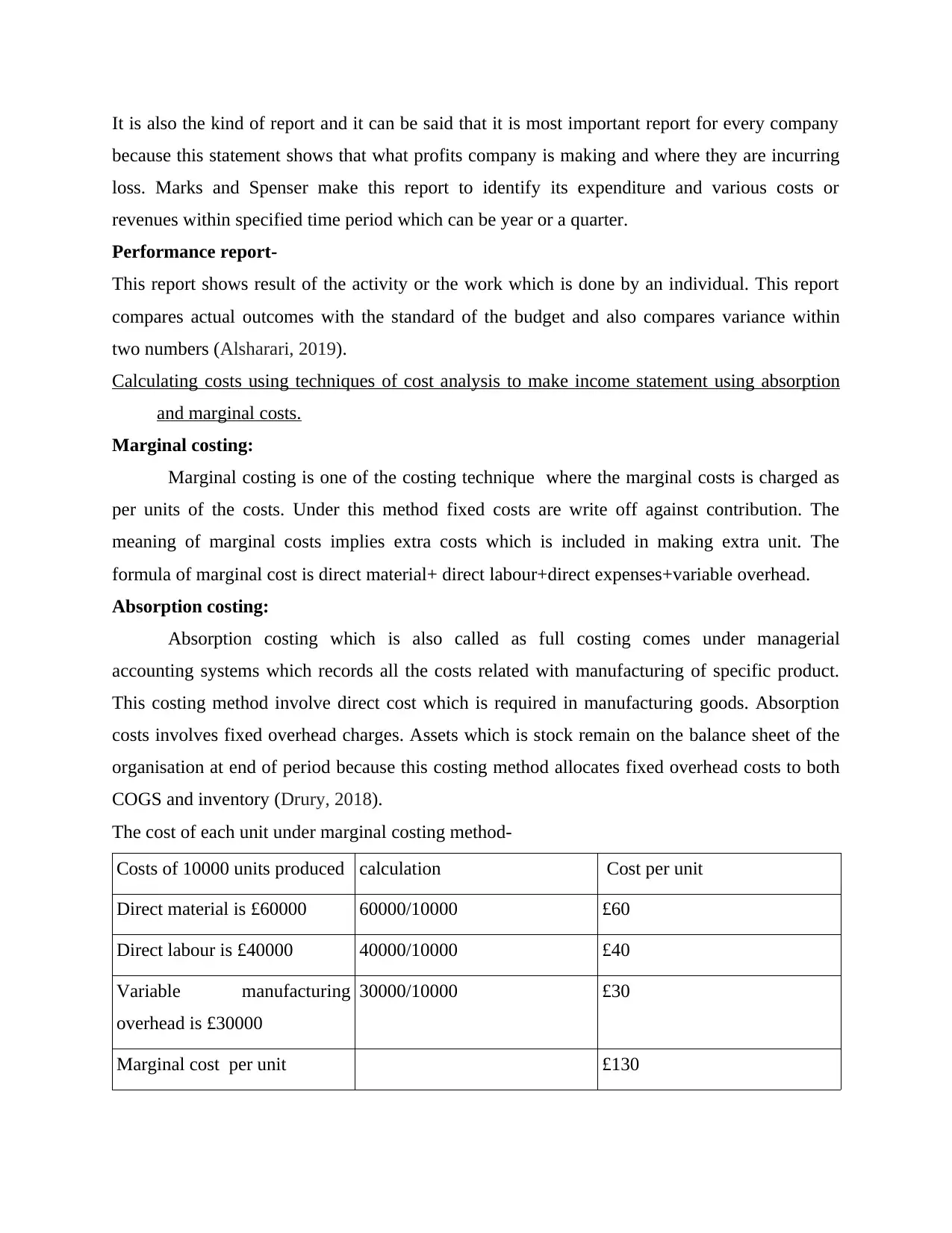
It is also the kind of report and it can be said that it is most important report for every company
because this statement shows that what profits company is making and where they are incurring
loss. Marks and Spenser make this report to identify its expenditure and various costs or
revenues within specified time period which can be year or a quarter.
Performance report-
This report shows result of the activity or the work which is done by an individual. This report
compares actual outcomes with the standard of the budget and also compares variance within
two numbers (Alsharari, 2019).
Calculating costs using techniques of cost analysis to make income statement using absorption
and marginal costs.
Marginal costing:
Marginal costing is one of the costing technique where the marginal costs is charged as
per units of the costs. Under this method fixed costs are write off against contribution. The
meaning of marginal costs implies extra costs which is included in making extra unit. The
formula of marginal cost is direct material+ direct labour+direct expenses+variable overhead.
Absorption costing:
Absorption costing which is also called as full costing comes under managerial
accounting systems which records all the costs related with manufacturing of specific product.
This costing method involve direct cost which is required in manufacturing goods. Absorption
costs involves fixed overhead charges. Assets which is stock remain on the balance sheet of the
organisation at end of period because this costing method allocates fixed overhead costs to both
COGS and inventory (Drury, 2018).
The cost of each unit under marginal costing method-
Costs of 10000 units produced calculation Cost per unit
Direct material is £60000 60000/10000 £60
Direct labour is £40000 40000/10000 £40
Variable manufacturing
overhead is £30000
30000/10000 £30
Marginal cost per unit £130
because this statement shows that what profits company is making and where they are incurring
loss. Marks and Spenser make this report to identify its expenditure and various costs or
revenues within specified time period which can be year or a quarter.
Performance report-
This report shows result of the activity or the work which is done by an individual. This report
compares actual outcomes with the standard of the budget and also compares variance within
two numbers (Alsharari, 2019).
Calculating costs using techniques of cost analysis to make income statement using absorption
and marginal costs.
Marginal costing:
Marginal costing is one of the costing technique where the marginal costs is charged as
per units of the costs. Under this method fixed costs are write off against contribution. The
meaning of marginal costs implies extra costs which is included in making extra unit. The
formula of marginal cost is direct material+ direct labour+direct expenses+variable overhead.
Absorption costing:
Absorption costing which is also called as full costing comes under managerial
accounting systems which records all the costs related with manufacturing of specific product.
This costing method involve direct cost which is required in manufacturing goods. Absorption
costs involves fixed overhead charges. Assets which is stock remain on the balance sheet of the
organisation at end of period because this costing method allocates fixed overhead costs to both
COGS and inventory (Drury, 2018).
The cost of each unit under marginal costing method-
Costs of 10000 units produced calculation Cost per unit
Direct material is £60000 60000/10000 £60
Direct labour is £40000 40000/10000 £40
Variable manufacturing
overhead is £30000
30000/10000 £30
Marginal cost per unit £130
Paraphrase This Document
Need a fresh take? Get an instant paraphrase of this document with our AI Paraphraser
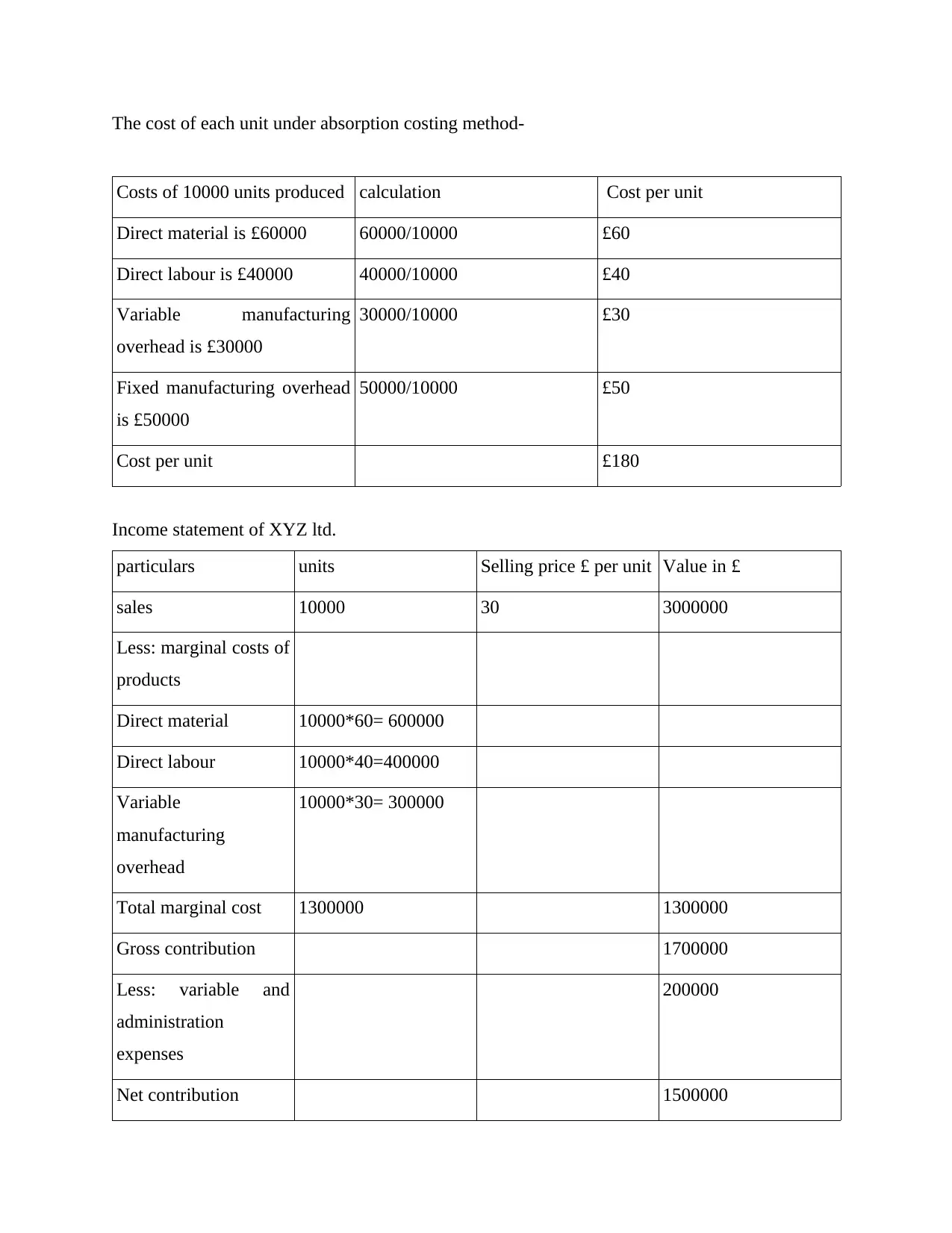
The cost of each unit under absorption costing method-
Costs of 10000 units produced calculation Cost per unit
Direct material is £60000 60000/10000 £60
Direct labour is £40000 40000/10000 £40
Variable manufacturing
overhead is £30000
30000/10000 £30
Fixed manufacturing overhead
is £50000
50000/10000 £50
Cost per unit £180
Income statement of XYZ ltd.
particulars units Selling price £ per unit Value in £
sales 10000 30 3000000
Less: marginal costs of
products
Direct material 10000*60= 600000
Direct labour 10000*40=400000
Variable
manufacturing
overhead
10000*30= 300000
Total marginal cost 1300000 1300000
Gross contribution 1700000
Less: variable and
administration
expenses
200000
Net contribution 1500000
Costs of 10000 units produced calculation Cost per unit
Direct material is £60000 60000/10000 £60
Direct labour is £40000 40000/10000 £40
Variable manufacturing
overhead is £30000
30000/10000 £30
Fixed manufacturing overhead
is £50000
50000/10000 £50
Cost per unit £180
Income statement of XYZ ltd.
particulars units Selling price £ per unit Value in £
sales 10000 30 3000000
Less: marginal costs of
products
Direct material 10000*60= 600000
Direct labour 10000*40=400000
Variable
manufacturing
overhead
10000*30= 300000
Total marginal cost 1300000 1300000
Gross contribution 1700000
Less: variable and
administration
expenses
200000
Net contribution 1500000
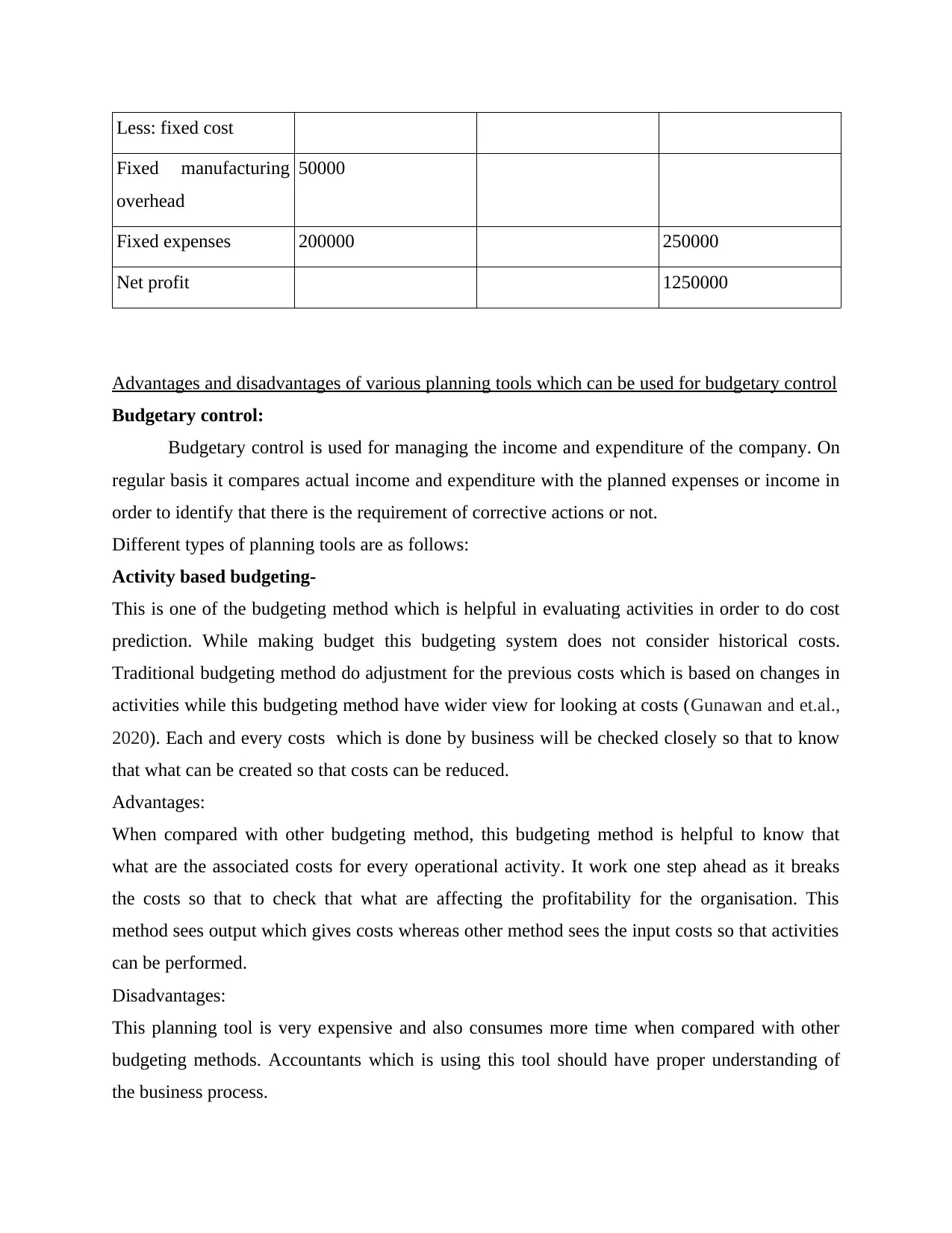
Less: fixed cost
Fixed manufacturing
overhead
50000
Fixed expenses 200000 250000
Net profit 1250000
Advantages and disadvantages of various planning tools which can be used for budgetary control
Budgetary control:
Budgetary control is used for managing the income and expenditure of the company. On
regular basis it compares actual income and expenditure with the planned expenses or income in
order to identify that there is the requirement of corrective actions or not.
Different types of planning tools are as follows:
Activity based budgeting-
This is one of the budgeting method which is helpful in evaluating activities in order to do cost
prediction. While making budget this budgeting system does not consider historical costs.
Traditional budgeting method do adjustment for the previous costs which is based on changes in
activities while this budgeting method have wider view for looking at costs (Gunawan and et.al.,
2020). Each and every costs which is done by business will be checked closely so that to know
that what can be created so that costs can be reduced.
Advantages:
When compared with other budgeting method, this budgeting method is helpful to know that
what are the associated costs for every operational activity. It work one step ahead as it breaks
the costs so that to check that what are affecting the profitability for the organisation. This
method sees output which gives costs whereas other method sees the input costs so that activities
can be performed.
Disadvantages:
This planning tool is very expensive and also consumes more time when compared with other
budgeting methods. Accountants which is using this tool should have proper understanding of
the business process.
Fixed manufacturing
overhead
50000
Fixed expenses 200000 250000
Net profit 1250000
Advantages and disadvantages of various planning tools which can be used for budgetary control
Budgetary control:
Budgetary control is used for managing the income and expenditure of the company. On
regular basis it compares actual income and expenditure with the planned expenses or income in
order to identify that there is the requirement of corrective actions or not.
Different types of planning tools are as follows:
Activity based budgeting-
This is one of the budgeting method which is helpful in evaluating activities in order to do cost
prediction. While making budget this budgeting system does not consider historical costs.
Traditional budgeting method do adjustment for the previous costs which is based on changes in
activities while this budgeting method have wider view for looking at costs (Gunawan and et.al.,
2020). Each and every costs which is done by business will be checked closely so that to know
that what can be created so that costs can be reduced.
Advantages:
When compared with other budgeting method, this budgeting method is helpful to know that
what are the associated costs for every operational activity. It work one step ahead as it breaks
the costs so that to check that what are affecting the profitability for the organisation. This
method sees output which gives costs whereas other method sees the input costs so that activities
can be performed.
Disadvantages:
This planning tool is very expensive and also consumes more time when compared with other
budgeting methods. Accountants which is using this tool should have proper understanding of
the business process.
⊘ This is a preview!⊘
Do you want full access?
Subscribe today to unlock all pages.

Trusted by 1+ million students worldwide
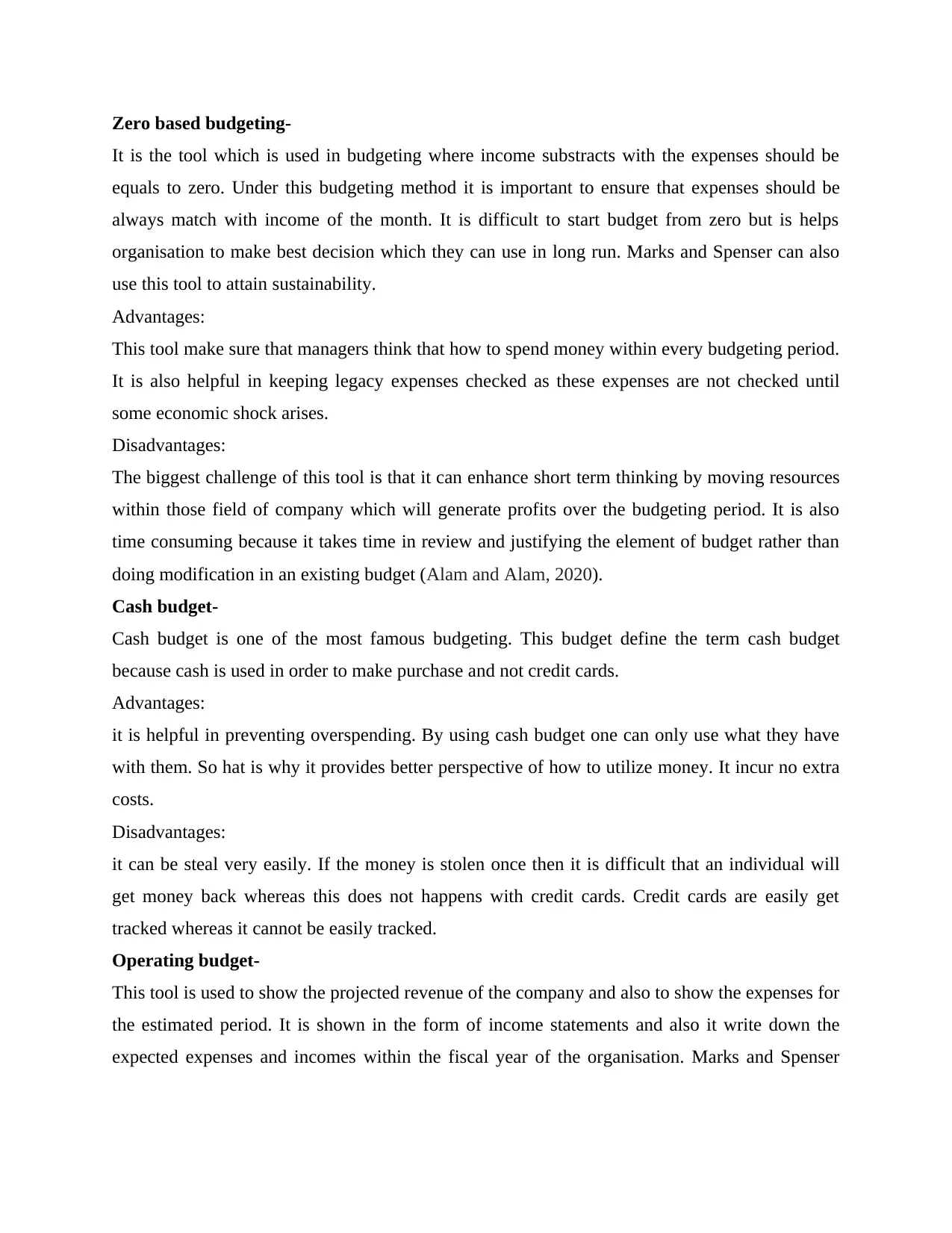
Zero based budgeting-
It is the tool which is used in budgeting where income substracts with the expenses should be
equals to zero. Under this budgeting method it is important to ensure that expenses should be
always match with income of the month. It is difficult to start budget from zero but is helps
organisation to make best decision which they can use in long run. Marks and Spenser can also
use this tool to attain sustainability.
Advantages:
This tool make sure that managers think that how to spend money within every budgeting period.
It is also helpful in keeping legacy expenses checked as these expenses are not checked until
some economic shock arises.
Disadvantages:
The biggest challenge of this tool is that it can enhance short term thinking by moving resources
within those field of company which will generate profits over the budgeting period. It is also
time consuming because it takes time in review and justifying the element of budget rather than
doing modification in an existing budget (Alam and Alam, 2020).
Cash budget-
Cash budget is one of the most famous budgeting. This budget define the term cash budget
because cash is used in order to make purchase and not credit cards.
Advantages:
it is helpful in preventing overspending. By using cash budget one can only use what they have
with them. So hat is why it provides better perspective of how to utilize money. It incur no extra
costs.
Disadvantages:
it can be steal very easily. If the money is stolen once then it is difficult that an individual will
get money back whereas this does not happens with credit cards. Credit cards are easily get
tracked whereas it cannot be easily tracked.
Operating budget-
This tool is used to show the projected revenue of the company and also to show the expenses for
the estimated period. It is shown in the form of income statements and also it write down the
expected expenses and incomes within the fiscal year of the organisation. Marks and Spenser
It is the tool which is used in budgeting where income substracts with the expenses should be
equals to zero. Under this budgeting method it is important to ensure that expenses should be
always match with income of the month. It is difficult to start budget from zero but is helps
organisation to make best decision which they can use in long run. Marks and Spenser can also
use this tool to attain sustainability.
Advantages:
This tool make sure that managers think that how to spend money within every budgeting period.
It is also helpful in keeping legacy expenses checked as these expenses are not checked until
some economic shock arises.
Disadvantages:
The biggest challenge of this tool is that it can enhance short term thinking by moving resources
within those field of company which will generate profits over the budgeting period. It is also
time consuming because it takes time in review and justifying the element of budget rather than
doing modification in an existing budget (Alam and Alam, 2020).
Cash budget-
Cash budget is one of the most famous budgeting. This budget define the term cash budget
because cash is used in order to make purchase and not credit cards.
Advantages:
it is helpful in preventing overspending. By using cash budget one can only use what they have
with them. So hat is why it provides better perspective of how to utilize money. It incur no extra
costs.
Disadvantages:
it can be steal very easily. If the money is stolen once then it is difficult that an individual will
get money back whereas this does not happens with credit cards. Credit cards are easily get
tracked whereas it cannot be easily tracked.
Operating budget-
This tool is used to show the projected revenue of the company and also to show the expenses for
the estimated period. It is shown in the form of income statements and also it write down the
expected expenses and incomes within the fiscal year of the organisation. Marks and Spenser
Paraphrase This Document
Need a fresh take? Get an instant paraphrase of this document with our AI Paraphraser
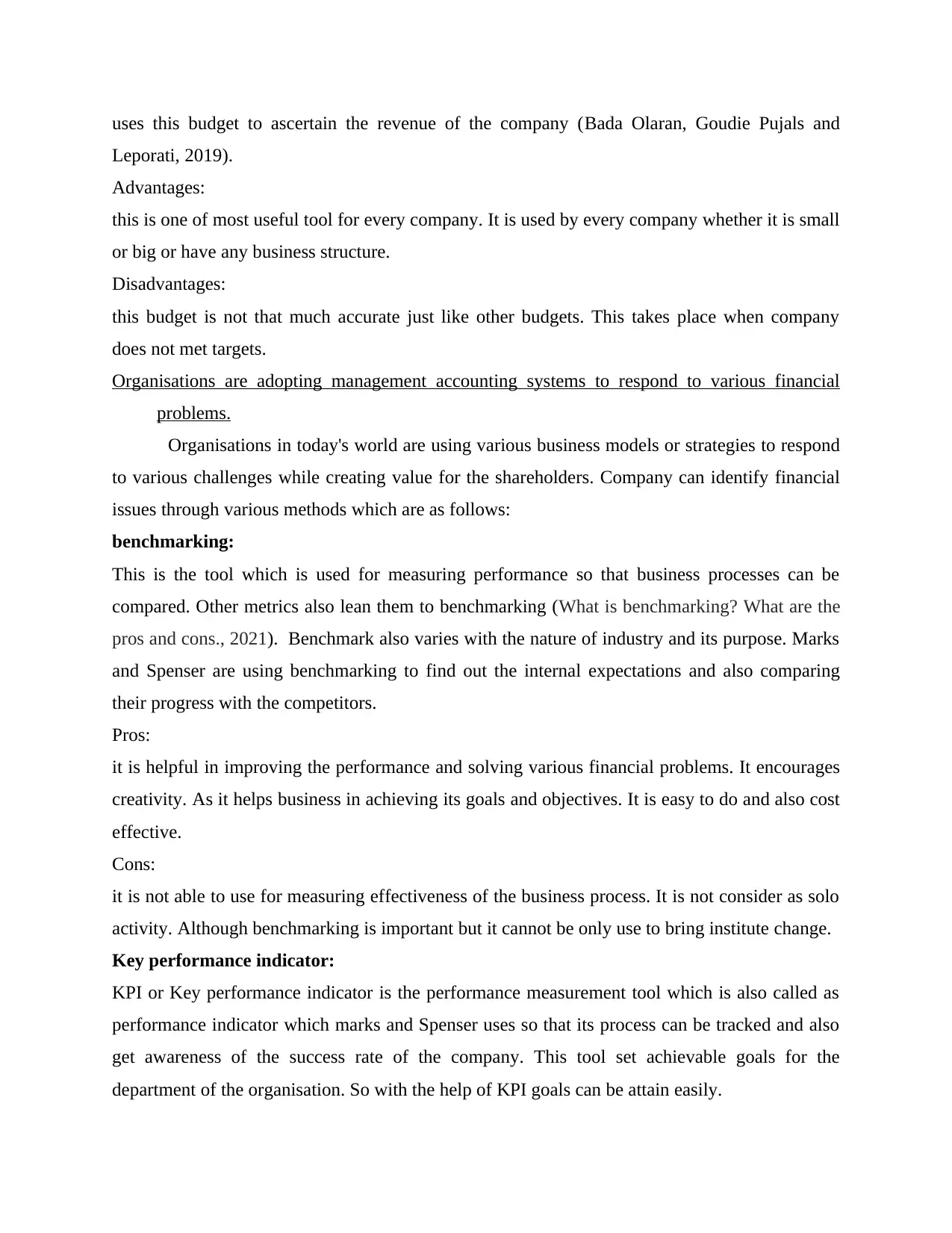
uses this budget to ascertain the revenue of the company (Bada Olaran, Goudie Pujals and
Leporati, 2019).
Advantages:
this is one of most useful tool for every company. It is used by every company whether it is small
or big or have any business structure.
Disadvantages:
this budget is not that much accurate just like other budgets. This takes place when company
does not met targets.
Organisations are adopting management accounting systems to respond to various financial
problems.
Organisations in today's world are using various business models or strategies to respond
to various challenges while creating value for the shareholders. Company can identify financial
issues through various methods which are as follows:
benchmarking:
This is the tool which is used for measuring performance so that business processes can be
compared. Other metrics also lean them to benchmarking (What is benchmarking? What are the
pros and cons., 2021). Benchmark also varies with the nature of industry and its purpose. Marks
and Spenser are using benchmarking to find out the internal expectations and also comparing
their progress with the competitors.
Pros:
it is helpful in improving the performance and solving various financial problems. It encourages
creativity. As it helps business in achieving its goals and objectives. It is easy to do and also cost
effective.
Cons:
it is not able to use for measuring effectiveness of the business process. It is not consider as solo
activity. Although benchmarking is important but it cannot be only use to bring institute change.
Key performance indicator:
KPI or Key performance indicator is the performance measurement tool which is also called as
performance indicator which marks and Spenser uses so that its process can be tracked and also
get awareness of the success rate of the company. This tool set achievable goals for the
department of the organisation. So with the help of KPI goals can be attain easily.
Leporati, 2019).
Advantages:
this is one of most useful tool for every company. It is used by every company whether it is small
or big or have any business structure.
Disadvantages:
this budget is not that much accurate just like other budgets. This takes place when company
does not met targets.
Organisations are adopting management accounting systems to respond to various financial
problems.
Organisations in today's world are using various business models or strategies to respond
to various challenges while creating value for the shareholders. Company can identify financial
issues through various methods which are as follows:
benchmarking:
This is the tool which is used for measuring performance so that business processes can be
compared. Other metrics also lean them to benchmarking (What is benchmarking? What are the
pros and cons., 2021). Benchmark also varies with the nature of industry and its purpose. Marks
and Spenser are using benchmarking to find out the internal expectations and also comparing
their progress with the competitors.
Pros:
it is helpful in improving the performance and solving various financial problems. It encourages
creativity. As it helps business in achieving its goals and objectives. It is easy to do and also cost
effective.
Cons:
it is not able to use for measuring effectiveness of the business process. It is not consider as solo
activity. Although benchmarking is important but it cannot be only use to bring institute change.
Key performance indicator:
KPI or Key performance indicator is the performance measurement tool which is also called as
performance indicator which marks and Spenser uses so that its process can be tracked and also
get awareness of the success rate of the company. This tool set achievable goals for the
department of the organisation. So with the help of KPI goals can be attain easily.
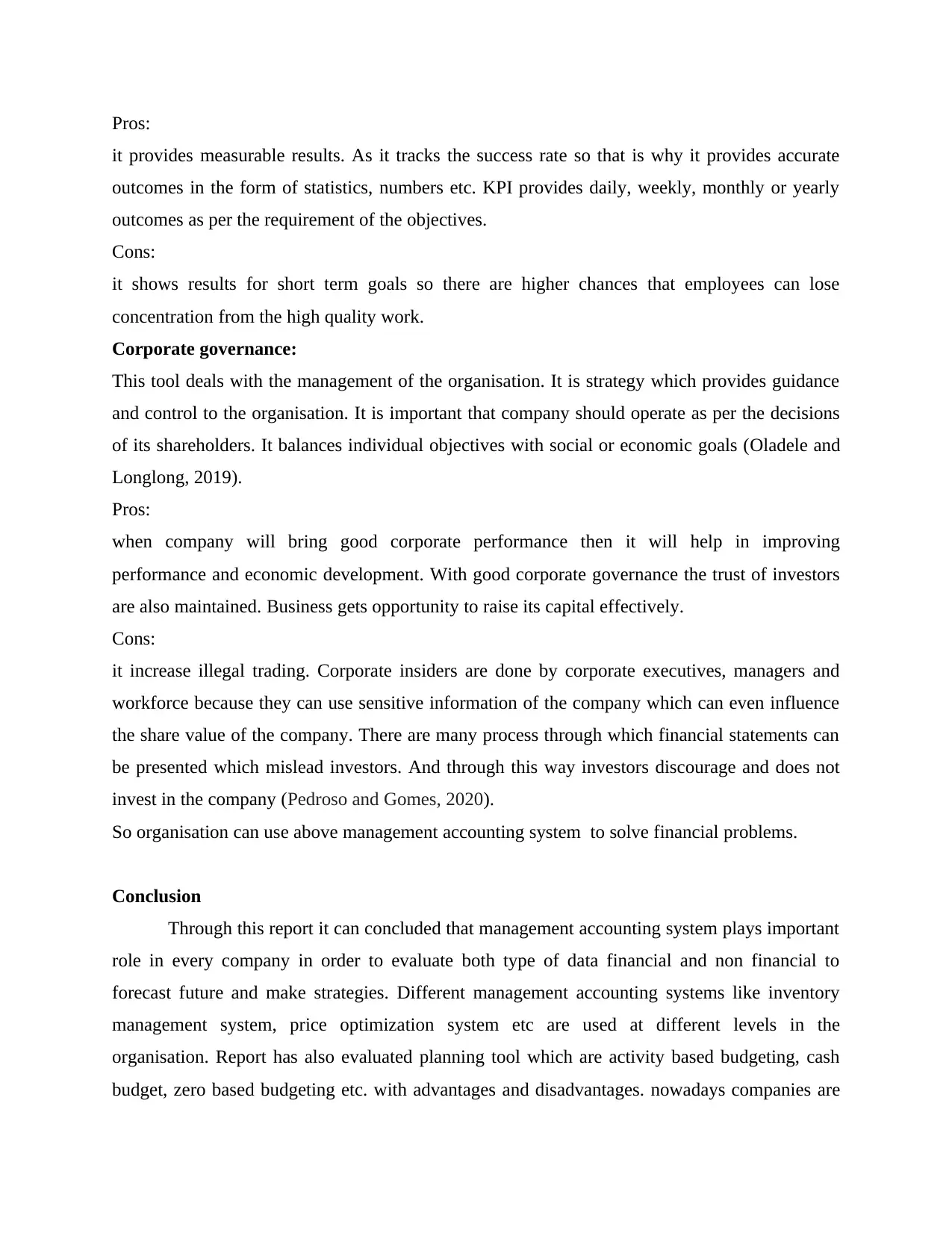
Pros:
it provides measurable results. As it tracks the success rate so that is why it provides accurate
outcomes in the form of statistics, numbers etc. KPI provides daily, weekly, monthly or yearly
outcomes as per the requirement of the objectives.
Cons:
it shows results for short term goals so there are higher chances that employees can lose
concentration from the high quality work.
Corporate governance:
This tool deals with the management of the organisation. It is strategy which provides guidance
and control to the organisation. It is important that company should operate as per the decisions
of its shareholders. It balances individual objectives with social or economic goals (Oladele and
Longlong, 2019).
Pros:
when company will bring good corporate performance then it will help in improving
performance and economic development. With good corporate governance the trust of investors
are also maintained. Business gets opportunity to raise its capital effectively.
Cons:
it increase illegal trading. Corporate insiders are done by corporate executives, managers and
workforce because they can use sensitive information of the company which can even influence
the share value of the company. There are many process through which financial statements can
be presented which mislead investors. And through this way investors discourage and does not
invest in the company (Pedroso and Gomes, 2020).
So organisation can use above management accounting system to solve financial problems.
Conclusion
Through this report it can concluded that management accounting system plays important
role in every company in order to evaluate both type of data financial and non financial to
forecast future and make strategies. Different management accounting systems like inventory
management system, price optimization system etc are used at different levels in the
organisation. Report has also evaluated planning tool which are activity based budgeting, cash
budget, zero based budgeting etc. with advantages and disadvantages. nowadays companies are
it provides measurable results. As it tracks the success rate so that is why it provides accurate
outcomes in the form of statistics, numbers etc. KPI provides daily, weekly, monthly or yearly
outcomes as per the requirement of the objectives.
Cons:
it shows results for short term goals so there are higher chances that employees can lose
concentration from the high quality work.
Corporate governance:
This tool deals with the management of the organisation. It is strategy which provides guidance
and control to the organisation. It is important that company should operate as per the decisions
of its shareholders. It balances individual objectives with social or economic goals (Oladele and
Longlong, 2019).
Pros:
when company will bring good corporate performance then it will help in improving
performance and economic development. With good corporate governance the trust of investors
are also maintained. Business gets opportunity to raise its capital effectively.
Cons:
it increase illegal trading. Corporate insiders are done by corporate executives, managers and
workforce because they can use sensitive information of the company which can even influence
the share value of the company. There are many process through which financial statements can
be presented which mislead investors. And through this way investors discourage and does not
invest in the company (Pedroso and Gomes, 2020).
So organisation can use above management accounting system to solve financial problems.
Conclusion
Through this report it can concluded that management accounting system plays important
role in every company in order to evaluate both type of data financial and non financial to
forecast future and make strategies. Different management accounting systems like inventory
management system, price optimization system etc are used at different levels in the
organisation. Report has also evaluated planning tool which are activity based budgeting, cash
budget, zero based budgeting etc. with advantages and disadvantages. nowadays companies are
⊘ This is a preview!⊘
Do you want full access?
Subscribe today to unlock all pages.

Trusted by 1+ million students worldwide
1 out of 14
Related Documents
Your All-in-One AI-Powered Toolkit for Academic Success.
+13062052269
info@desklib.com
Available 24*7 on WhatsApp / Email
![[object Object]](/_next/static/media/star-bottom.7253800d.svg)
Unlock your academic potential
Copyright © 2020–2025 A2Z Services. All Rights Reserved. Developed and managed by ZUCOL.





